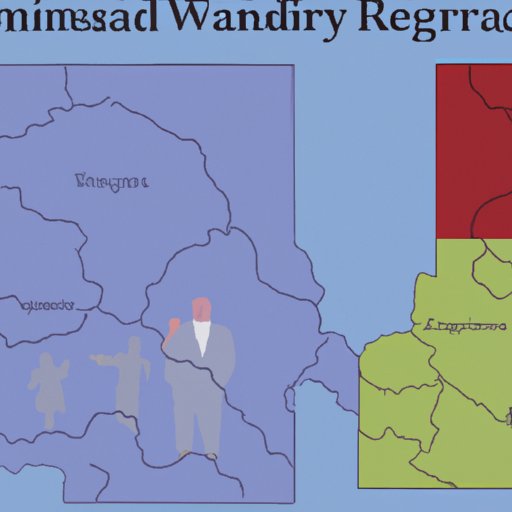Introduction
Gerrymandering is a controversial political practice that has been used for centuries to gain an electoral advantage. It is a process in which electoral districts are drawn with the intention of favoring one party over another. While the term ‘gerrymandering’ originated in the United States, it is now used around the world to describe any type of manipulation of electoral boundaries for political gain. In this article, we will explore what gerrymandering is, how it works, and its impact on elections. We will also examine the different types of gerrymandering, as well as the pros and cons of the practice.
Explaining Gerrymandering: A Step-by-Step Guide
To understand gerrymandering, it is important to first define the related concept of redistricting. Redistricting is the process of redrawing electoral district lines to reflect population changes within a jurisdiction. After a census is conducted, state legislatures are responsible for redrawing district lines to ensure that every voter’s vote carries equal weight. This process is known as redistricting.
The role of the legislature in redistricting is critical to understanding how gerrymandering works. The legislature is typically responsible for drawing up the new district maps, which means they can use their power to draw the lines in a way that benefits their party. This is the essence of gerrymandering. By manipulating the district lines, the party in power can increase their chances of winning an election by ensuring that their supporters are concentrated in certain districts.
Gerrymandering works by creating “safe” districts for the controlling party. Safe districts are those that have a large number of voters from one party, making it unlikely that a candidate from a different party could win the election. Gerrymandering also works by diluting the voting power of minority groups. By spreading out minority voters across multiple districts, the controlling party can reduce the impact of their votes.
How Gerrymandering Affects Elections
Gerrymandering can have a significant impact on elections. By creating safe districts for their party, the controlling party can gain a political advantage in the election. This gives them a leg up on their opponents, allowing them to win more seats in the legislature and maintain control of the government. Gerrymandering can also lead to unfair representation in Congress, as some districts may be overrepresented while others are underrepresented.
What is Gerrymandering and Why Does it Happen?
Gerrymandering is a process of manipulating electoral districts to gain a political advantage. It is done by the party in power in order to increase their chances of winning an election. Gerrymandering is often motivated by a desire to protect incumbents or to gain control of the legislature. It is also used to dilute the voting power of minority groups, thus ensuring that their voices are not heard in the electoral process.
Gerrymandering has been used for centuries, but it has become increasingly common in recent years. In 2018, the U.S. Supreme Court ruled that partisan gerrymandering was unconstitutional, yet many states continue to engage in the practice. Examples of gerrymandering include the creation of oddly shaped districts, the splitting of cities and towns into multiple districts, and the packing of minority voters into a single district.

The Pros and Cons of Gerrymandering
Gerrymandering can be seen as both a positive and negative practice. On the one hand, it can give an advantage to the party in power and allow them to remain in control of the government. On the other hand, it can lead to unfair representation and dilute the voting power of minority groups. Ultimately, it is up to the public to decide whether or not the practice should be allowed.

Understanding the History and Impact of Gerrymandering
Gerrymandering has been around since the late 18th century. It was named after Elbridge Gerry, who was governor of Massachusetts in 1812. Gerry signed a bill that redrew the state’s electoral districts in a way that benefited his party. The resulting map was so strange in shape that it was likened to a salamander, thus giving rise to the term ‘gerrymandering’.
Since then, gerrymandering has had a significant impact on politics. It has been used to maintain power for the party in power, to dilute the voting power of minority groups, and to create unfair advantages in elections. As a result, it has led to increased polarization in politics and decreased faith in the democratic process.
Examining Different Types of Gerrymandering
Gerrymandering can take two forms: racial gerrymandering and partisan gerrymandering. Racial gerrymandering is the practice of creating electoral districts that favor one racial group over another. Partisan gerrymandering is the practice of creating districts that favor one political party over another. Both types of gerrymandering have been used throughout history to gain an electoral advantage.
Conclusion
Gerrymandering is a controversial political practice used to gain an electoral advantage. It is a process in which electoral districts are drawn with the intention of favoring one party over another. Gerrymandering can have a significant impact on elections, leading to political polarization and decreased faith in the democratic process. It also has the potential to create unfair representation in Congress and dilute the voting power of minority groups. Ultimately, it is up to the public to decide if gerrymandering should be allowed.
(Note: Is this article not meeting your expectations? Do you have knowledge or insights to share? Unlock new opportunities and expand your reach by joining our authors team. Click Registration to join us and share your expertise with our readers.)
